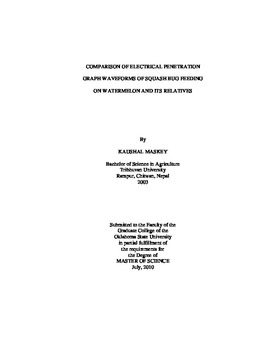| dc.contributor.advisor | Wayadande, Astri | |
| dc.contributor.author | Maskey, Kaushal | |
| dc.date.accessioned | 2014-04-15T21:16:48Z | |
| dc.date.available | 2014-04-15T21:16:48Z | |
| dc.date.issued | 2010-07-01 | |
| dc.identifier.uri | https://hdl.handle.net/11244/9001 | |
| dc.description.abstract | Cucurbit yellow vine disease is caused by the bacterium Serratia marcescens, which is transmitted by the squash bug, a serious pest of cucurbit. Watermelon is an economically important crop and serves as an alternate host of the squash bug. There is no any watermelon cultivar resistant of CYVD and squash bug. In this study, we characterized and compared the squash bug feeding behavior on watermelon "Royal Sweet" with the feeding behavior on watermelon relatives, Citrulluscolocynthis, Praecitrullusfistulosus and USVL-200, using electrical penetration graph technology to understand squash bug host preference. Feeding behavior of squash bug on watermelon "Royal Sweet" was categorized into four different waveform patterns; non probing, test probe, salivation or pathway and ingestion. Non probing waveform which includes squash bug activities other than stylet insertion was longest than test probe, pathway and ingestion waveform. Test probes were the most prevalent probing waveforms. Pathway waveform was shorter with high amplitude than ingestion, and occurs in the same probe which includes ingestion. Ingestion waveform was the longest waveform among squash bug probing waveform. Labial angle during probing was associated with the ingestion behavior. Squash bugs were more attracted to watermelon hybrid, USVL-200 when given choice and probed more on watermelon cv. Royal Sweet and USVL-200 when given no choice showing that Citrullus colocynthis lines and Praecitrullus fistulosus are less preferred by the squash bug. There was no difference in the time taken by the insect to initiate first probe and first probe with ingestion, and duration of first probe and first probe with ingestion. It indicated that the squash bug probing was not affected by the host physical structure or plant volatiles. Longer duration of ingestion in Royal Sweet than on other test plants species indicate that squash bug ingestion behavior on watermelon relatives was altered when the stylet reached vascular bundle. There might be some difference in the sap content of these plants which reduced sustained ingestion by the squash bug. Information from this study can be used further to understand the mechanism of pathogen inoculation by the squash bug and to identify the possible gene responsible for squash bug resistance. | |
| dc.format | application/pdf | |
| dc.language | en_US | |
| dc.publisher | Oklahoma State University | |
| dc.rights | Copyright is held by the author who has granted the Oklahoma State University Library the non-exclusive right to share this material in its institutional repository. Contact Digital Library Services at lib-dls@okstate.edu or 405-744-9161 for the permission policy on the use, reproduction or distribution of this material. | |
| dc.title | Comparison of Electrical Penetration Graph Waveforms of Squash Bug Feeding on Watermelon and Its Relatives | |
| dc.type | text | |
| dc.contributor.committeeMember | Fletcher, Jacqueline | |
| dc.contributor.committeeMember | Giles, Kristopher L. | |
| osu.filename | Maskey_okstate_0664M_10919.pdf | |
| osu.college | Agricultural Sciences and Natural Resources | |
| osu.accesstype | Open Access | |
| dc.description.department | Department of Entomology and Plant Pathology | |
| dc.type.genre | Thesis | |
| dc.subject.keywords | cucurbit yellow vine disease | |
| dc.subject.keywords | electrical penetration graph | |
| dc.subject.keywords | feeding behavior | |
| dc.subject.keywords | serratia marcescens | |
| dc.subject.keywords | squash bug | |
| dc.subject.keywords | watermelon | |
